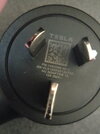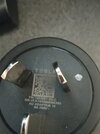doggy1
Member
Just a couple of observations.
1. You do not state what the voltage was.
2. I assume you are quoting the Pilot Signal amps rather than the actual amps?
3. I looked back at 300 charge sessions and my average, which is remarkably consistent across all charging, AC and DC is 7.3km/kW. Of course, this is rated km per nett kWHr (not gross kWHr). Very similar to your 3LR which is just one year earlier (but slightly different battery), so very consistent.
4. I have just done a number of measurements at a variety of (single-phase) currents. Whereas my low end percentage is not as bad as the figures I was quoting, it is not too crash-hot. Aircon and lights and radio all off. The DC-DC converter was pulling 320W for all sessions. The coolant pumps were running at 5.6 to 6L/M for all sessions. The AC charger will be less efficient at lower amperages (semiconductor voltage drops et al). The radiator fan was not running. However, I am betting it was running when I measured a few months ago in summer where the ambient would have been 30+ and battery cells around 35degC. Today, ambient was 23degC and mid-cell battery temperature was 25degC. Here is the data:
1. You do not state what the voltage was.
2. I assume you are quoting the Pilot Signal amps rather than the actual amps?
3. I looked back at 300 charge sessions and my average, which is remarkably consistent across all charging, AC and DC is 7.3km/kW. Of course, this is rated km per nett kWHr (not gross kWHr). Very similar to your 3LR which is just one year earlier (but slightly different battery), so very consistent.
4. I have just done a number of measurements at a variety of (single-phase) currents. Whereas my low end percentage is not as bad as the figures I was quoting, it is not too crash-hot. Aircon and lights and radio all off. The DC-DC converter was pulling 320W for all sessions. The coolant pumps were running at 5.6 to 6L/M for all sessions. The AC charger will be less efficient at lower amperages (semiconductor voltage drops et al). The radiator fan was not running. However, I am betting it was running when I measured a few months ago in summer where the ambient would have been 30+ and battery cells around 35degC. Today, ambient was 23degC and mid-cell battery temperature was 25degC. Here is the data:
| | Tesla Model 3LR AC charging efficiency @ 23degC | | | |
| | | | | |
Pilot | Actual amps | Volts @ car | Power in (W) | Power Batt (W) | Efficiency |
| | | | | |
5 | 5.28 | 241 | 1272.48 | 750 | 58.9% |
6 | 6.16 | 240 | 1478.4 | 980 | 66.3% |
7 | 7.48 | 239 | 1787.72 | 1215 | 68.0% |
8 | 8.36 | 239 | 1998.04 | 1450 | 72.6% |
9 | 9.46 | 239 | 2260.94 | 1750 | 77.4% |
10 | 10.34 | 239 | 2471.26 | 1940 | 78.5% |
12 | 12.10 | 236 | 2855.6 | 2350 | 82.3% |
14 | 14.30 | 236 | 3374.8 | 2780 | 82.4% |
16 | 16.11 | 234 | 3769.74 | 3240 | 85.9% |
20 | 20.24 | 233 | 4715.92 | 4000 | 84.8% |
24 | 24.20 | 230 | 5566 | 4890 | 87.9% |
27 | 27.06 | 228 | 6169.68 | 5450 | 88.3% |
30 | 29.92 | 228 | 6821.76 | 6240 | 91.5% |
32 | 31.90 | 225 | 7177.5 | 6620 | 92.2% |




